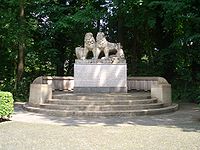Wilhelm Nida-Rümelin
Wilhelm Nida-Rümelin (born November 27, 1876 in Linz , † in May 1945 near Schäftlarn ) was an Austro-German sculptor of the classical tradition of the 20th century.
Career and education
Wilhelm was born out of wedlock to Wilhelm Rümelin and Franziska Nida.
After the death of his parents, Wilhelm Nida-Rümelin was accepted into a monastery in Linz and began an apprenticeship at a shipyard, but soon switched to an apprenticeship as a sculptor; learned different techniques: clay, plaster, wood, stone, stucco (the latter was a solid basis for the fresco technique for him). After completing his journeyman's examination, he traveled to the then flourishing art city of Munich in 1895 (where he acquired Bavarian citizenship in 1913). By Friedrich von Thiersch he got an order to contribute to the artistic design of the Palace of Justice. He was a student of Professor Wilhelm von Rümann at the Academy of Fine Arts and assistant to the sculptor Ernst Pfeifer. He founded a studio in Munich and received orders for freelance work in Munich, Bremen and Essen. In 1906 Wilhelm Nida-Rümelin was appointed to teach the sculpture class at the Kassel School of Applied Arts. This was followed by a two-year study visit to Rome, from 1908 to 1910. He then moved back to Munich and worked as a freelance sculptor and fresco painter.
On December 1, 1923, Wilhelm Nida-Rümelin accepted a call as a full professor for sculpture and ceramics at the then Nuremberg School of Applied Arts (from 1928 State School for Applied Arts, later Nuremberg Academy of Fine Arts ). After his retirement on October 1, 1941, he worked again in Munich, where he rented the large studio in the Hildebrandhaus , until his suicide in May 1945.
Wilhelm Nida-Rümelin was the father of the sculptor Rolf Nida-Rümelin and the grandfather of the philosophers Julian Nida-Rümelin and Martine Nida-Rümelin .
Art perception and work
The classical tradition, in which Wilhelm Nida-Rümelin stands, was linked to Greek sculpture in the late 19th century. Adolf von Hildebrand, who worked in Italy and from the turn of the century in Munich, had a great influence in theory and practice on the work of Wilhelm Nida-Rümelin, who worked in his former studio in the Hildebrandhaus in Munich in the 1940s. Like the representatives of the New Objectivity art movement , late classicism of the early twentieth century was not considered degenerate during the Nazi era and was tolerated. He adapted in part to the National Socialist ideal of art. His teacher Wilhelm von Rümann, but also Ernst Pfeifer, were also considered to be representatives of the “classical form”. This also applies to some of Wilhelm Nida-Rümelin's later works. The overall oeuvre between 1900 and 1944 is complex - it ranges from filigree fresco and stucco works to portraits, animal sculptures, fountains to individual monumental works of the late phase, which are far behind the earlier works in terms of artistic quality. As a fresco painter, he used the lost traditional technique and showed that, contrary to expectations, it is sustainable. As a sculptor and art professor, he practiced and propagated a close connection between craft and art, a rehabilitation of "applied arts" and the freedom of architecture and artistic design.
During the Nazi era he received public commissions and was one of "Hitler's artists" such as Arno Breker , Josef Thorak and others. a. According to Joe F. Bodenstein, this is said to have been deliberately concealed by his descendants: "Wilhelm Nida-Rümelin fell into oblivion after 1945 because his descendants obviously deliberately suppressed and kept secret the artist's work during the Nazi era." April 20, 2005)
Works

- 1905: The fairy in the city garden of Essen
- 1913: Stucco work at the Heilbronn City Theater
- 1919: Sculptures for Villa Lindenhof (entrepreneur Max Robert Wieland, 1867–1936)
- 1924: War memorial in Ismaning (implementation as a model)
- 1931: Fresco town hall Lindau (dance of death theme, painted over in 1971)
- 1933: Julius Streicher sculpture
- 1939: The armory - in the entrance area of the DAF
- 1940: Striding woman with cloth
- 1942: Bust of Hermann Göring (Linz Prize for Fine Arts)
literature
- G. Wacha: Nida-Rümelin Wilhelm. In: Austrian Biographical Lexicon 1815–1950 (ÖBL). Volume 7, Verlag der Österreichischen Akademie der Wissenschaften, Vienna 1978, ISBN 3-7001-0187-2 , p. 114.
Web links
- Professor Wilhelm Nida-Rümelin. NordOstKultur Munich
- Parks in Essen. Fee by Wilhelm Nida-Rümelin
- Wilhelm Nida-Rümelin and the Villa Lindenhof
- Frank M. Kammel, The Sculptor W. NR. , 2012 ( page no longer available , search in web archives )
- Siegfried Schödel, Caesarean section on Wolf. Mural in the municipal women's clinic in Nuremberg (PDF; 775 kB)
- Joe F. Bodenstein: The sculptor Wilhelm Nida-Rümelin: A forgotten master of the classical tradition . meaus.com. Retrieved May 19, 2011.
| personal data | |
|---|---|
| SURNAME | Nida-Rümelin, Wilhelm |
| BRIEF DESCRIPTION | German sculptor |
| DATE OF BIRTH | November 27, 1876 |
| PLACE OF BIRTH | Linz |
| DATE OF DEATH | May 1945 |
| Place of death | Schäftlarn |
